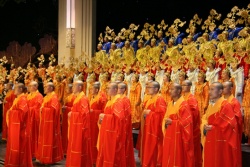Difference between revisions of "Monks and Nuns"
| Line 2: | Line 2: | ||
The [[Triple Jewel]] can be pursued at different levels. In the {{Wiki|East}}, there is a long [[tradition]] of [[monastic]] orders, or [[monks]] ([[bikkhu]]) and [[nuns]] ([[bhikkunis]]). To become a [[monk]] or [[nun]] is to devote yourself to [[spiritual]] [[life]]. A child is old enough to become a [[monk]] when he can “scare the [[crows]] away,” which usually means about seven or eight years old. | The [[Triple Jewel]] can be pursued at different levels. In the {{Wiki|East}}, there is a long [[tradition]] of [[monastic]] orders, or [[monks]] ([[bikkhu]]) and [[nuns]] ([[bhikkunis]]). To become a [[monk]] or [[nun]] is to devote yourself to [[spiritual]] [[life]]. A child is old enough to become a [[monk]] when he can “scare the [[crows]] away,” which usually means about seven or eight years old. | ||
| − | The [[Buddha]] accepted his [[son Rahula]] into the [[sangha]] when he was only seven years old. [[Seeing]] the [[grief]] this [[caused]] [[Rahula]]'s grandfather [[Sudhodhona]], the [[Buddha]] made a subsequent rule about the minimum age for [[bikkhus]] entering the [[sangha]]. | + | The [[Buddha]] accepted his [[son Rahula]] into the [[sangha]] when he was only seven years old. [[Seeing]] the [[grief]] this [[caused]] [[Rahula]]'s grandfather [[Sudhodhona]], the [[Buddha]] made a subsequent {{Wiki|rule}} about the minimum age for [[bikkhus]] entering the [[sangha]]. |
In the [[Buddha]]'s [[time]], [[monks]] upon joining the [[sangha]] were told the four things they could always use for the four basic necessities of [[life]]: the foot of a [[tree]] for accommodation, [[robes]] made of rags for clothing, [[food]] [[offered]] as [[alms]], and fermented cow's {{Wiki|urine}} for [[medicine]]. If you become [[ordained]] in the [[Zen]] or {{Wiki|Tibetan}} [[Buddhist]] [[traditions]] today, the basic necessities have been updated! But [[life]] would remain simple. | In the [[Buddha]]'s [[time]], [[monks]] upon joining the [[sangha]] were told the four things they could always use for the four basic necessities of [[life]]: the foot of a [[tree]] for accommodation, [[robes]] made of rags for clothing, [[food]] [[offered]] as [[alms]], and fermented cow's {{Wiki|urine}} for [[medicine]]. If you become [[ordained]] in the [[Zen]] or {{Wiki|Tibetan}} [[Buddhist]] [[traditions]] today, the basic necessities have been updated! But [[life]] would remain simple. | ||
Latest revision as of 18:58, 8 March 2015
The Triple Jewel can be pursued at different levels. In the East, there is a long tradition of monastic orders, or monks (bikkhu) and nuns (bhikkunis). To become a monk or nun is to devote yourself to spiritual life. A child is old enough to become a monk when he can “scare the crows away,” which usually means about seven or eight years old.
The Buddha accepted his son Rahula into the sangha when he was only seven years old. Seeing the grief this caused Rahula's grandfather Sudhodhona, the Buddha made a subsequent rule about the minimum age for bikkhus entering the sangha.
In the Buddha's time, monks upon joining the sangha were told the four things they could always use for the four basic necessities of life: the foot of a tree for accommodation, robes made of rags for clothing, food offered as alms, and fermented cow's urine for medicine. If you become ordained in the Zen or Tibetan Buddhist traditions today, the basic necessities have been updated! But life would remain simple.
A monk in the Buddha's time was allowed eight possessions: three robes, a water strainer, a begging bowl, a needle, razor, and a belt. Monks and nuns are expected to shave their heads and live a life of celibacy.
Why do Buddhist monks have to be celibate?
On the point of celibacy, it is not clear whether the Buddha recommended this, as was the custom of the day, or as means to limit the material resources the sangha would require (it takes more food to support families than solitary monks). It is not clear that the Buddha's teaching or the dharma require celibacy. Householders (as lay practitioners are called in India) have been known to reach enlightenment too, although the demands of daily life will make this more challenging.
Monasteries can be quite elaborate and large social institutions. For example, the Abhayagiri monastery in fifth-century Sri Lanka had 5,000 monks. Prior to China's invasion of Tibet in 1959, the Drepung monastery housed 10,000 monks. These monks need quarters, meals, and a place to worship. Many Asian monasteries nurture a pipal tree (or the Bodhi Tree), the tree under which Siddhartha reached his great awakening.
